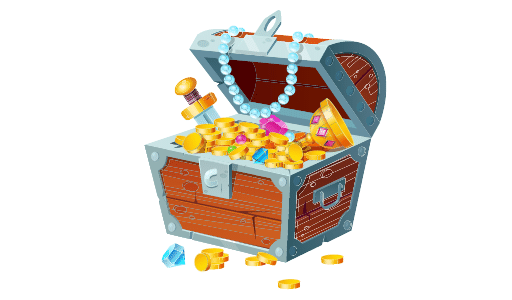The History of Loot Boxes
So what are loot boxes, exactly? While critics of the mechanic would be quick to tell you that they are “basically gambling,” their true nature is much more complex and nuanced. And to get a better understanding of the many ways in which they are implemented in video games, we have to go back through the history of gambling and trace the loot box back to its source.
It can be argued that one of the earliest precursors to the modern video game loot box is found in the “gashapon,” a Japanese vending machine that dispensed a random capsule toy from a predefined collection. This idea would later make its way into a particular breed of video game called a gacha game, which makes use of this concept as its primary means of collecting new in-game items like characters or equipment.

A separate origin point for the video game loot box could also be found in collectible trading card games. These games sold booster packs, small sets of usually around 10 cards each, that allowed players to expand or boost their current collection of trading cards. Similar to the gachapon, trading card booster packs give random cards from a predefined collection, with different cards having different levels of either rarity or usefulness within the context of the card game. For collectors in particular, the most sought-after cards are those with special holographic or reflective elements printed on the cards in addition to their striking and distinct design, which are commonly referred to as "holo cards" or "foil cards".
The third and last potential origin for loot boxes in video games could be considered to come from massively multiplayer online role-playing games, or MMORPGs. In this context, an early ancestor of the loot box could be found in the method by which certain in-game equipment, items, or materials may drop after defeating a certain enemy. In most circumstances, desirable items (such as new weapons and armor) have a very low chance of dropping from these enemies, often in the low single-digit percent every time you defeat them. This mechanic encourages players to develop strategies and techniques to defeat these monsters faster and therefore get more chances of dropping the rare equipment.
All of these origin points will eventually find their way into modern loot box mechanics in one way or another, as we will discuss in the next section.

How Do Loot Boxes Work?
With our historical context now established, now would be an appropriate time to examine how loot box systems work in modern video games. As we’ve seen from our historical precedents, we find that loot boxes come in various forms, thereby making them more of a catch-all term for a method of monetization used in a video game rather than a single game mechanic on its own.
The Gacha System
One of the chief examples of this is the gacha mechanic that we mentioned previously. As with its origin, this variation of the loot box concept is very popular among Asian developers, particularly in the mobile gaming space.
(Fun fact: The first gacha game is generally accepted to be the Chinese free-to-play game ZT Online from 2007, and has most of the hallmarks of the gacha systems we see today.)
In a typical gacha game (Genshin Impact is a popular and recent example), characters and equipment can be obtained by opening loot boxes or gacha that require “ticket” items that can be obtained as rewards from completing objectives in the game or by purchasing them for real money.
Opening a gacha (also referred to as “pulling,” “wishing,” or other terms established by the game’s community) will tap into an RNG system in the game that is connected to a specific drop table for the gacha. This drop table establishes the probabilities of obtaining a certain character or item, with more desirable ones having a much lower probability.
Depending on its implementation, the gacha mechanic may also have a “pity” system along with it, which guarantees that an item of a certain rarity will drop after a predetermined number of gacha “pulls.” This system takes its inspiration from collectible trading card games such as Yu-Gi-Oh and Magic: the Gathering, wherein each booster pack will have at least one card with a certain desirable quality.
Loot Box
At this point, we have already written at length about gacha systems, so what of the loot box?
Here’s the kicker: everything we’ve discussed about the mechanics of gacha systems also applies to loot boxes. All loot boxes can either be obtained from in-game progression or purchased with real money. Loot boxes give you a random set of items based on a drop table that defines the chance that any given item can be obtained in that loot box. And in some cases, higher rarity items may be set to always appear after opening a predefined amount of loot boxes.
So what’s the difference here? It all comes down to game monetization.
For developers of gacha games, the gacha system serves as their primary (and in some cases, only) source of revenue, allowing them to focus on other aspects of the game. Since all gacha games are free to play, a lot of design decisions are made in these games to encourage players to spend real money on gacha tickets in order to advance further in the game.
Meanwhile, loot box systems (such as those found in games like Overwatch and the FIFA games developed by Electronic Arts) exist as a means of generating additional revenue on top of a game that already requires payment to play. Overwatch, for example, is a competitive shooter game that costs C$25 for the base game and C$50 for an “enhanced edition” that includes additional in-game items in addition to the base game. FIFA 22, on the other hand, already costs $80 Canadian dollars just to have the privilege of playing the game itself.
Pay-to-Win and the Problem with Loot Boxes
In the grand scheme of things, loot boxes are generally pretty innocuous - they are a slightly different way of acquiring in-game items that also enable developers to integrate a monetization scheme to generate revenue for a game that otherwise does not have any.
All loot box systems do give players the ability to open loot boxes or gachas by simply progressing through the game, but given the profit incentive, developers can and do make the free-to-play or “F2P” aspect of their games much more difficult and tedious.
At this point, we are probably very familiar with how loot box systems generally work. However, we have yet to actually consider the value of the actual items that players can get from loot boxes, and it is here that we run into a potentially serious issue.
Any fans of gacha games will probably be aware of a term called P2W, which is short for “pay to win”. Saying that a game is P2W means that the game’s monetization is structured in a way that forces players to spend and play with real money in order to have the means to perform well in the game’s progression or competition systems.
To help us illustrate how this works, let us go back to our two example games that we mentioned earlier in the article: Genshin Impact and FIFA 22. Genshin Impact is a single-player gacha game that features a growing roster of characters and arsenal of equipment that has varying degrees of strength depending on their rarity. Their rarity system is described in stars, in which 5-star characters and equipment are both the rarest and the most powerful.
While the game does everything in its power to convince players to pull on the gacha system, there is no actual need to do so as the entirety of the game world is designed to be accessible by a starting roster of four characters that are provided to you through normal progression in the game. This means that Genshin Impact is not considered to be a P2W game as players can effectively complete all of the game's content without needing to pay anything.
Meanwhile, the loot box system in the FIFA games (starting from FIFA 15) is integrated into their competitive online mode called Ultimate Team. While most of the standard gameplay gives players access to all of the teams and players in FIFA to tinker with, Ultimate Team ditches all of that for a completely custom team that you have to build from character cards.

These cards are the basis of the loot box system in FIFA, which can give out either cosmetics or characters with a generally similar system of the character’s usefulness in-game being tied to their rarity. However, where FIFA deviates from Genshin Impact is that the characters in FIFA will be used to compete with other players on the Ultimate Team game mode.
Such a system effectively forces players to spend large sums of money in order to have a team that is able to compete at a high level, which simultaneously also skews the game towards a situation in which the best players in the game are those who have already made a huge financial investment to do so. This is what is called “Pay to Win.”
And just in case all of this has seemed pretty harmless to you, let us give you a quick reminder that all of the games we have mentioned so far are just a small subset of the many, many modern video games that have loot box or gacha mechanics built-in, and many of them are not only played by, but specifically marketed to minors.
Are Loot Boxes Gambling?
With all of the information that we have gathered and discussed thus far, we find ourselves at the critical question: are loot boxes actually gambling?
As we established at the beginning of this article, there is a long and ongoing debate about whether or not to consider loot boxes any different to online gambling in Canada, thereby forcing it and the developers who implement these systems in their games to fall under the regulation of national gambling regulators.
One of the problems with this is that there isn't yet an internationally recognized definition for what a loot box system actually is. We already explained earlier that the system used in single-player gacha games is vastly different from that of a paid competitive sports title, and many other games use all sorts of different variations on the loot box system in order to best fit the monetization goals of the developers.
Exactly what aspects of loot box systems should be banned, or if they should be banned at all, is still up for debate.
Of course, that is not to say that there haven't been any attempts to regulate or otherwise remove these loot box systems. One of the most notable examples was in 2019, when the Dutch courts issued a €10 million fine over loot boxes to Electronic Arts, in relation to their FIFA game. A year earlier, legislators in Belgium had even passed a law that outright banned the implementation of all paid loot boxes in video games that serve players in their jurisdiction. A landmark investigation from the Belgium Gaming Commission found that paid loot box systems violated gambling laws in the country, citing its dangers to mental health, especially those of children.
As a result, all video games in the country had the paid loot box function removed completely, although players could still acquire loot boxes from gameplay rewards.
Meanwhile, the class-action lawsuit filed in Canada against developer Electronic Arts has yet to reach a decision in the courts, but it has sparked a similar discussion in the country on what its stand should be towards loot box systems.
Until there are further developments, though, loot boxes will stick around for a long time yet.




